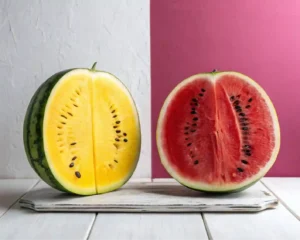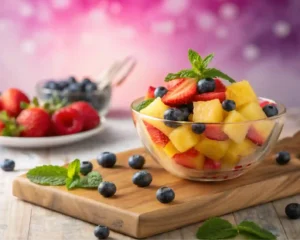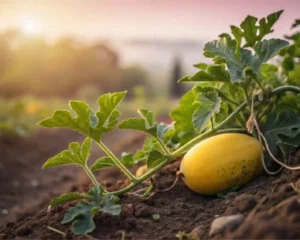Yellow watermelons are a vibrant twist on the traditional red fleshed fruit, sparking curiosity with their sunny hue, sweet flavor, and unique charm. While these yellow colored watermelons may seem bizarre to some, they have been cultivated for centuries. But just how rare is a yellow watermelon, and why does its flesh differ from the typical red? Let’s delve into the fascinating origins of yellow watermelon and uncover the truth about this fruit
Table of contents
Introduction
What Is a Yellow Watermelon?
They are a variety of watermelon with bright yellow flesh. Unlike the familiar red watermelon, their sunny interior is due to a difference in natural pigments. These melons belong to the same species, Citrullus lanatus, but their genetic makeup gives them their distinct color.
Often sweeter than their red counterparts, yellow watermelons have a tropical taste with hints of honey and apricot. Their unique appearance and flavor make them a popular choice for those seeking something different.
Their Origins
Yellow watermelons trace their roots to Africa, where wild varieties with yellow flesh were first cultivated. Over time, selective breeding led to the development of the red fleshed varieties we know today. However, yellow watermelons have remained an integral part of watermelon cultivation in many parts of the world.
“Yellow watermelons remind us of nature’s incredible diversity—just when you think you’ve seen it all, something beautiful surprises you!”
Why Is Watermelon Yellow?
The yellow color of a watermelon is due to the absence of lycopene, the compound responsible for the red color in traditional watermelons. Instead, yellow watermelons are rich in betacarotene, the same pigment that gives carrots their orange hue.
Beta-carotene is also an antioxidant, contributing to the health benefits of yellow watermelons. This difference in pigmentation is purely genetic and doesn’t affect the overall nutritional value of the fruit.
For more fascinating food insights, explore How to Add Flavor to Bland Chicken Casserole.
Its Rarity
How Rare Are Yellow Watermelons Compared to Red?
Yellow watermelons are less common than red ones, primarily due to market demand. Red watermelons dominate the shelves because they are more familiar to consumers. Farmers grow more red varieties because they sell better, making yellow watermelons a rarer find.
That said, yellow watermelons are not impossible to locate. They are fairly available in specialty markets, farmers’ markets, and during peak watermelon seasons.
Factors Influencing the Availability of Yellow Watermelons
The rarity of yellow watermelons depends on several factors:
- Consumer Demand: Red watermelons are more popular, leading to fewer yellow options being grown.
- Seasonality: Yellow watermelons are usually available during the summer months when watermelons are in peak season.
- Local Production: Regions that embrace diverse crops are more likely to grow and sell yellow watermelons.
“Yellow watermelons are like hidden gems in the produce aisle—once you find them, they’re hard to forget!”
Regions Where Yellow Watermelons Are Grown
Yellow watermelons are cultivated worldwide but are most commonly grown in:
- The United States: Particularly in California and Texas.
- Asia: Countries like Japan and Thailand are known for their fascinating fruit varieties.
- Africa: The birthplace of watermelons, including yellow fleshed ones.
Their availability varies based on local growing conditions and the time of year.
The Science, Benefits, and Common Misconceptions
The Science Behind Yellow Watermelon
Yellow watermelons are not just visually striking—they’re scientifically intriguing as well. Let’s explore the genetic and nutritional factors that make them unique.

Genetics of Yellow Watermelon Pigmentation
The unique yellow color of these watermelons comes down to genetics. Unlike red watermelons, which are rich in lycopene (the pigment that gives tomatoes and red fruits their color), yellow watermelons contain higher levels of betacarotene.
Beta-carotene is a naturally occurring pigment found in carrots, sweet potatoes, and pumpkins. It’s responsible for the yellow and orange hues in these foods. This pigment also acts as an anti oxidant, which means yellow watermelons may offer more health benefits.
Nutritional Differences Between Yellow and Red Watermelons
While yellow and red watermelons are both hydrating and nutrient rich, there are subtle differences in their nutritional profiles:
- Yellow Watermelon: Higher in betacarotene, which is converted to vitamin A in the body.
- Red Watermelon: Rich in lycopene, known for supporting heart health.
- Shared Benefits: Both varieties are low in calories, contain natural sugars, and are packed with vitamins C and A.
“Think of yellow watermelon as nature’s sweet treat—it’s delicious, refreshing, and good for your body!”
Taste and Texture: How Yellow Differs from Red
Yellow watermelons are often described as sweeter and more tropical than red options. Their flavor has subtle hints of honey, apricot, and even mango, making them a favorite for daring eaters.
In terms of texture, yellow watermelons are just as juicy and crisp as their red counterparts. They’re perfect for adding a pop of color and flavor to fruit salads, smoothies, or just enjoying on their own.
Benefits
Yellow watermelons are not just rare—they’re also incredibly beneficial. Here’s why you should consider adding them to your diet.
Health Benefits
- Rich in Antioxidants: Beta-carotene helps combat oxidative stress and supports skin and eye health.
- Hydrating: Like red watermelons, yellow ones are about 90% water, making them an excellent choice for staying hydrated.
- Low in Calories: A guilt free snack that satisfies your sweet tooth without adding extra calories.
- Supports Immune Health: Packed with vitamin C, yellow watermelons boost your immune system.
Culinary Uses
Yellow watermelons aren’t just for eating raw—they’re versatile in the kitchen too! Here are some creative ways to use them:
- Smoothies: Blend yellow watermelon with mint and lime for a refreshing drink.
- Fruit Salads: Combine yellow watermelon with berries, pineapple, and kiwi for a colorful medley.
- Sorbet: Puree yellow watermelon, freeze it, and enjoy a naturally sweet sorbet.
- Grilled: Slice into wedges and grill for a smoky, caramelized treat.

“Yellow watermelons are like sunshine on a plate—bright, sweet, and perfect for every occasion!”
Why You Should Try them
Yellow watermelons are a delightful way to break out of your usual fruit routine. Their unique flavor, nutritional benefits, and aesthetic appeal make them a standout choice for any meal or snack.
For creative fruit recipes, check out How to Add Flavor to Bland Chicken Casserole.
Common Problems and Misconceptions
Is it Safe to Eat?
Yes, yellow watermelons are perfectly safe to eat! Their color is a natural result of genetic variation, not a sign of spoil or artificial tampering.
Why Is My Watermelon Yellow Inside? Is It Normal?
If you slice into a watermelon expecting red flesh but find it yellow, don’t panic! This simply means you have a yellow watermelon variety, which is entirely normal and delicious.
“A surprise it is like a bonus gift—it’s unexpected, but oh so rewarding!”
Are Yellow Watermelons Genetically Modified?
No, yellow watermelons are not genetically modified (GMOs). They are a naturally occurring variety that has been cultivated for centuries. Their color is the result of natural genetic differences, not artificial intervention.
Growing, Fun Facts, and Why Yellow Watermelon Is Worth Your Attention
Growing and Harvesting
Yellow watermelons might seem non native, but with the right knowledge, you can grow them at home or find them at local markets. Here’s how to bring this vibrant fruit into your garden or onto your table.

How to Grow Yellow Watermelons at Home
Growing yellow watermelons isn’t much different from cultivating their red counterparts. Follow these steps to enjoy homegrown sunshine on your plate:
- Choose the Right Seeds: Start with seeds specifically labeled for yellow watermelon varieties, such as Yellow Crimson or Desert King.
- Pick a Sunny Spot: Watermelons need at least 6–8 hours of direct sunlight daily.
- Prepare the Soil: Yellow watermelons thrive in well draining soil with a slightly acidic to neutral pH (6.0–7.0). Add compost to enrich the soil with nutrients.
- Planting: Sow seeds directly into the ground or start them indoors in seed trays. Space them 3–5 feet apart to allow room for their sprawling vines.
- Water Wisely: Keep the soil consistently moist but avoid overwatering. Reduce watering when the fruit starts ripening to concentrate the sweetness.
- Harvesting: Yellow watermelons are ready to harvest when the underside turns creamy yellow and they produce a deep hollow sound when tapped.
“Growing yellow watermelons is like planting a surprise—each fruit is a little piece of sunshine waiting to brighten your day.”
Tips for Identifying Ripe Yellow Watermelon
Choosing a ripe yellow watermelon can be tricky, but these tips will help:
- Look for a Yellow Spot: A ripe yellow watermelon will have a creamy yellow spot on its underside where it rested on the ground.
- Check the Sound: Tap the melon; a deep, hollow sound usually is a sign that it’s ready to eat.
- Check the skin to ensure it looks dull rather than shiny, and look for well-defined stripes (if any).
Common Issues When Growing Yellow Watermelons
Growing watermelons can come with a few challenges:
- Pests: Watch out for aphids and cucumber beetles, which can damage vines and fruit.
- Blossom End Rot: Caused by inconsistent watering or calcium deficiency, this appears as a dark spot on the fruit.
- Slow Growth: Watermelons need warm temperatures to thrive; plant them only when the soil is consistently warm.
Fun Facts
Farmers grow yellow watermelons in several regions around the world.
Historical Facts About Yellow Watermelon
- Historians believe that people in Africa cultivated yellow watermelons as one of the first varieties. Red-fleshed watermelons are a more recent development.
- Historically, people considered yellow watermelons a delicacy and often reserved them for royalty in some cultures.
Surprising Culinary Dishes Featuring Yellow Watermelon
It adds a vibrant twist to classic recipes. Here are some dishes to try:
- Yellow Watermelon Gazpacho: A refreshing cold soup made with pureed yellow watermelon, cucumber, and mint.
- Yellow Watermelon Salsa: Dice yellow watermelon, jalapeños, cilantro, and lime juice for a tropical salsa.
- Watermelon Skewers: Alternate yellow and red watermelon cubes on skewers for a stunning party appetizer.
“Yellow watermelons are like the party guest who steals the spotlight—they add flavor and flair to every dish.”
Yellow Watermelon in Global Food Culture
People celebrate them around the world:
- Japan: Known for their love of unique fruit, Japan features yellow watermelons in high end markets and as gifts.
- Thailand: Yellow watermelons are a common sight at markets, often used in fruit carvings for special occasions.
- United States: While less common than red varieties, they’re gaining popularity in farmers’ markets and specialty stores.
For more creative fruit recipes, learn about unique side dishes in Top 7 Mushrooms Perfect for Pasta Dishes.
Frequently Asked Questions (FAQs)
What Are the Odds of Finding a Yellow Watermelon?
Yellow watermelons are less common than red varieties but are more available at specialty markets and during peak watermelon season.
Is Yellow Watermelon Sweeter Than Red?
Yes, yellow watermelons are generally sweeter and have a tropical flavor profile with hints of honey and apricot.
How Long Does Yellow Watermelon Last After Harvest?
Once harvested, yellow watermelons last about 1–2 weeks when stored in a cool, dry place. Refrigerate cut pieces and consume within 3–5 days.
Conclusion: Why Yellow Watermelon Deserves Attention
Yellow watermelon is more than just a rare fruit—it’s a delightful burst of sweetness and sunshine. From its vibrant color and health benefits to its versatility in the kitchen, it’s a fruit worth seeking out and savoring.
Whether you’re growing your own, hunting for one at the market, or trying it for the first time, yellow watermelon is a unique experience that brings joy and flavor to any occasion.
“When life gives you yellow watermelon, slice it, savor it, and let its sweetness brighten your day.”

